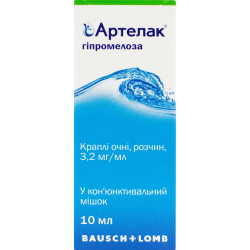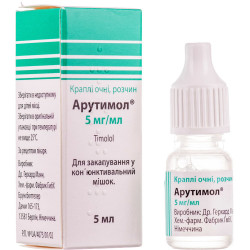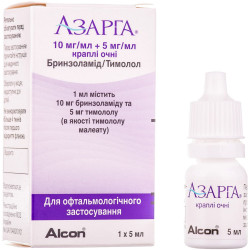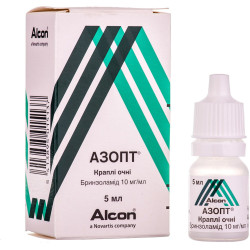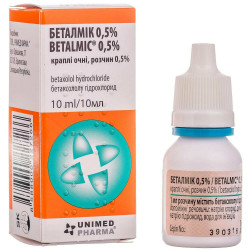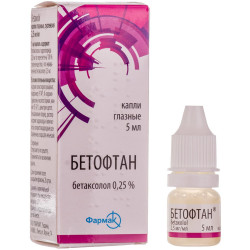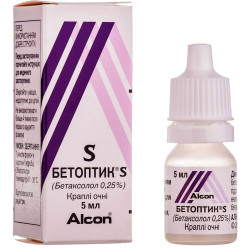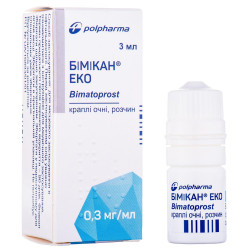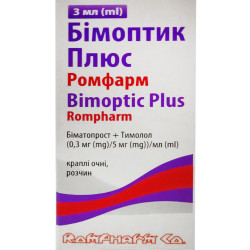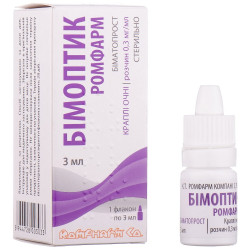





- Stock: In Stock
- Model: 179626
0% Customers recommend this product
-
5 Awesome0%
-
4 Great0%
-
3 Average0%
-
2 Bad0%
-
1 Poor0%
Reviews Over Monoprost cap. eye. solution 50mcg/ml Comte. 0.2 ml No. 30
- (0)
Total Reviews (0)
click here write review to add review for this product.
Report this review.
Description
Pharmacological properties
Pharmacodynamics. active ingredient latanoprost, f2α prostaglandin analog, is selection agonist of a prostanoid receptor fp which reduces intraocular pressure by increase in outflow of watery moisture. decrease in intraocular pressure at the person begins approximately in 3–4 h after administration of medicine, and the maximum effect is reached in 8–12 h the hypotensive action continues during not less than 24 h
Drug is effective as monotherapy. Besides, latanoprost it is effective in a combination with blockers of β-adrenoceptors (Timololum). Action of the latanoprost is additive at application in a combination with adrenergic agonists (epinephrine dipivalit), oral inhibitors of a karboangidraza (acetazoleamide) and at least partially additive at application with cholinergic agonists (pilocarpine).
Latanoprost does not influence considerably producing intraocular liquid. No influence of the latanoprost for a gematooftalmologichesky barrier is revealed.
Latanoprost did not cause leak of fluorescein in a back segment of an eye of the person at a psevdofakiya.
toIt is proved that latanoprost in therapeutic doses has no pharmacological effect on cardiovascular and respiratory systems.
Pharmacokinetics. Latanoprost treats pro-drugs. Its isopropyl ether which in itself is inactive at instillation in an eye is soaked up through a cornea, hydrolyzed by cornea esterases to the acid having biologically active effect.
C max in intraocular liquid is reached in 2 h after topical administration. Latanoprost it is distributed mainly in a front segment, a conjunctiva and centuries. Only the insignificant amount of medicine reaches a back segment.
byIn an eye latanoprost it is practically not metabolized. The main metabolism of medicine happens in a liver. T ½ makes 17 min.
as a part of Monoprost the innovation patented complex — protriaksin (carbomer + a macrogoal) which promotes stabilization of a molecule of the latanoprost in solution contains. He prevents subsidence of the latanoprost on walls of a plastic container and keeps effective concentration in each drop, reduces risk of development of local side reactions and xerophthalmus, allows to store a container at the room temperature, without use of preservatives.
Indication
For decrease in the increased intraocular pressure at patients with an open angle glaucoma and the increased intraocular pressure.
Use
Recommended dose for adults, including elderly people: on 1 drop in the affected eye of 1 times a day. the optimum effect is reached at use of medicine in the evening.
should not applyMonoprost more often than 1 time a day as it is shown that at more frequent application the efficiency of decrease in intraocular pressure decreases.
should continue byin case of the admission of a dose treatment, having accepted the following dose in usual time.
As well as for any eye drops, for reduction of possible system absorption when burying recommends to squeeze within 1 min. a dacryocyst in the field of a medial corner of an eye. It needs to be done at once after burying each drop.
Before burying drops eye should remove contact lenses. It is again possible to establish them in 15 min.
At application of several ophthalmologic means of local action should use medicaments with an interval not less than 5 min.
Instruction on an application order
1. Wash up hands, conveniently get up or sit down.
2. Delay a finger a lower eyelid of the affected eye down.
3. Bring a tip of an open one-dose container as it is possible closer to an eye, but do not concern them an eye surface.
4. Carefully squeeze a container that one drop got into an eye, and release a lower eyelid.
5. Close eyes and clamp a finger an internal corner of the dug eye for 1 min.
6. Repeat all above-stated actions with the second eye if the doctor so appointed.
7. The single container does not contain preservatives therefore the remains of contents should be utilized right after use. You do not store it for further use.
Children. Do not apply to children (up to 18 years).
Contraindication
Known hypersensitivity to any component of medicine.
Side effectsMajority of side reactions of a molecule of the latanoprost is connected by
with an organ of sight. it was reported about increase in pigmentation of an iris of the eye at application of the latanoprost. other side reactions, as a rule, passing are also observed only during burying.
Infectious and parasitic diseases: herpetic keratitis.
from nervous system: headache, dizziness.
from an organ of sight: the strengthened pigmentation of an iris of the eye; slight or moderate hyperaemia of a conjunctiva; irritation of an eye (burning with feeling of sand in an eye, an itch, pricking or feeling of a foreign body in an eye); changes in eyelashes and vellus hair (increase in length, thickness, pigmentation and quantity) (the vast majority of cases is marked out at Japanese patients), tranzitorny dot epithelial erosion, mainly asymptomatic; blepharitis; eye pain; photophobia; the century swelled; xerophthalmus; keratitis; misting of sight; conjunctivitis; an iritis/uveitis (the majority of cases is registered at patients with tendency to these diseases); macular hypostasis; symptomatic hypostases and erosion of a cornea; periorbital hypostasis; growth of eyelashes in the wrong direction that sometimes leads to irritation of an eye; emergence of an additional number of eyelashes in output channels of meibomian glands (distikhiaz); the periorbital changes and changes a century leading to deepening of a fold a century; iris cyst.
from heart: exacerbation of stenocardia at patients with this disease in the anamnesis, heart consciousness.
from the respiratory system, bodies of a thorax and mediastinum: OH, aggravation OH and short wind.
from skin and hypodermic cellulose: skin rash, darkening of a palpebral eyelid skin.
from the musculoskeletal system and connective tissue: myalgia, arthralgia.
General violations and reactions in the injection site: stethalgia.
Report on the suspected side reactions
Message about the suspected side reactions after registration of medicine is important. It allows to carry out continuous monitoring of a ratio risk/advantage for medicine. Health workers need to report about any suspected undesirable reactions through national reporting system.
Special instructionsLatanoprost gradual change of color of an eye due to increase in quantity of a brown pigment in an eye iris of the eye can cause
. even prior to treatment it is necessary to inform patients on a possibility of permanent discoloration of an eye. treatment only of one eye can result in permanent heterochromia. Discoloration of eyes is noted by
mainly at patients from the iris of the eye mixed by coloring, for example blue-brown, gray-brown, yellowy-brown or green-brown. Discoloration usually happens within the first 8 months of treatment, is rare — for 2nd or 3rd, but not after the 4th year of treatment. Progressing of pigmentation of an iris of the eye decreases over time and in 5 years is stabilized. The enhancement effect of pigmentation after 5 years of medicament treatment was not estimated. It was reported that at a 5-year research of safety of the latanoprost at 33% of patients strengthening of pigmentation of an iris of the eye of an eye (is registered see. SIDE EFFECTS). Discolorations of an iris are in most cases insignificant and are often clinically not significant. Frequency of cases at patients with the mixed color of an iris fluctuated from 7 to 85%, and at patients with yellowy-brown color of an iris the largest frequency is noted. Discolorations of eyes are not recorded at patients with uniform blue color of eyes and were rare at patients with uniform gray, green or brown color of eyes.
Discoloration happens because of increase in content of melanin in stromal melanocytes of an iris, but not because of increase in quantity of melanocytes. As a rule, brown pigmentation around a pupil extends concentrically in the direction of the periphery of the affected eye, however all iris of the eye or its parts can gain more brown color. After the termination of treatment of further strengthening of brown pigmentation of an iris it was not observed. There are no data that such phenomenon is connected with any symptoms or pathological to changes.
byin the presence of a nevus or freckles on an iris of the eye did not note their change under the influence of therapy. Accumulation of a pigment in a trabecular grid or in any other department of an anterior chamber of an eye was not observed. Increase in pigmentation of an iris of the eye does not cause clinical complications, and use of medicine can be continued if there was a change of pigmentation of an iris. However patients should undergo regular inspections and if that is demanded by a clinical situation, to stop medicament treatment.
Experience of application of the latanoprost is limited toat chronic closed-angle glaucoma, an open angle glaucoma at patients with a psevdofakiya and also at pigmentary glaucoma. Now there are no data on application of the latanoprost at inflammatory and neovascular glaucoma or at inflammatory diseases of eyes. Monoprost does not influence absolutely or slightly influences a pupil, however data on use of medicine at bad attacks of closed-angle glaucoma are absent. In this regard at such states it is recommended to use medicament with care.
Data on use of medicine during the perioperatsionny period at surgical treatment of a cataract are limited to. At such patients medicament should be used with care.
With care needs to be applied at patients with a herpetic keratitis in the anamnesis. In case of the active keratitis caused by a herpes simplex virus, to patients with the recurrent herpetic keratitis in the anamnesis which is especially connected with analogs of prostaglandins, use of medicine should be avoided.
concernedMessage about macular hypostasis (see. Side EFFECTS) generally sick with an aphakia, patients with a psevdofakiya with a rupture of the back capsule of a crystalline lens or an anterior chamber of a crystalline lens or patients with the known risk factors of cystous hypostasis of a makula (such as diabetic retinopathy and occlusion of veins of a retina of an eye).
Therefore to above-mentioned patients medicament should be used with care.
to Patients with the known risk factors of developing an iritis/uveitis can use medicament with care.
Experience of use of medicine for patients with is OH limited bythough there were messages about aggravation cases OH and/or asthmas. Patients about OH medicine should appoint with care (see also SIDE EFFECTS).
byobserved discolorations of skin in periorbital area, and the majority of cases is noted at the Japanese patients. The data which are available now demonstrate that change of coloring of skin in the periorbital site is not constant and in certain cases disappeared at medicament treatment continuation.
can gradually changeLatanoprost eyelashes and vellus hair around an eye in which the medicament and also in adjacent sites was administered; increase in length, thickness, pigmentation and number of hair in eyelashes or vellus hair and also growth of eyelashes in the wrong direction belong to these changes. Changes in eyelashes are reversible and disappear after the termination of administration of drug.
Monoprost contains makrogolglitserol hydroxystearate (the castor oil polyethoxylated, hydrogenated) and can cause allergic reactions of skin (see. Side EFFECTS). Now on this excipient there are no sufficient data on safety in case of long use.
Use during pregnancy and feeding by a breast
Pregnancy. Safety of this medicine for application for pregnant women is not established. Its pharmacological action makes potential risk for pregnancy course, for a fruit or the newborn. In this regard medicament should not be used during pregnancy.
Feeding by a breast. Latanoprost and its metabolites can get into breast milk therefore nursing it is necessary to stop treatment or to refuse feeding by a breast.
Fertility. In animal experiments the influence of the latanoprost for reproductive function at of both sexes is not revealed.
Ability to influence speed of response at control of vehicles or work with other mechanisms. As well as use of other medicines, burying eye drops can cause temporary illegibility of sight. Patients should not steer vehicles or to work with other mechanisms before restoration of clearness of sight.
do not have
Interaction
sufficient data concerning interaction of the latanoprost with other medicines. toIt was reported about paradoxical increase in intraocular pressure after simultaneous topical administration in eyes of two analogs of prostaglandins. Therefore it is not recommended to apply at the same time two or more prostaglandins, analogs of prostaglandins or their derivatives.
Research of interaction of medicines was conducted only with participation of adult patients.
Overdose
Krom of irritation of an eye and conjunctival hyperaemia, other side effects from an eye at overdose of medicine is not recorded.
Following information can be useful in case of accidental ingestion of medicine. One one-dose container contains 10 mkg of the latanoprost. Its more than 90% it is metabolized at the first passing through a liver. In/in infusion of medicine in a dose of 3 mkg/kg to healthy volunteers did not cause emergence of any symptoms, however in a dose of 5.5-10 mkg/kg provoked nausea, an abdominal pain, dizziness, increased fatigue, inflows and the increased sweating.
At application locally in a latanoprost eye in the doses, by 7 times exceeding a clinical dose of medicine at patients with moderated OH a bronchostenosis it is noted p.
should carry out byin case of overdose symptomatic treatment.
Storage conditions
At a temperature not above 25 °C.
After the first opening of a sachet to use one-dose containers within 7 days. After the first opening of a one-dose container its contents should be used at once and to utilize a one-dose container.
Specifications
| Characteristics | |
| Active ingredients | Latanoprost |
| Amount of active ingredient | 0.05 mg/ml |
| Applicant | Thea |
| Code of automatic telephone exchange | S01EE01 of Latanoprost |
| Interaction with food | It doesn't matter |
| Light sensitivity | Not sensitive |
| Market status | The branded generic |
| Origin | Chemical |
| Prescription status | According to the prescription |
| Primary packing | container |
| Producer | EKSELVIZION |
| Quantity in packing | 30 containers on 0.2 ml |
| Release form | eye drops |
| Route of administration | Eye |
| Sign | Import |
| Storage temperature | from 5 °C to 25 °C |
| Trade name | Monoprost |












